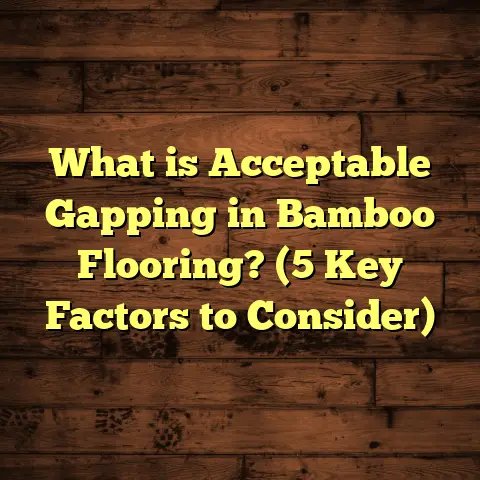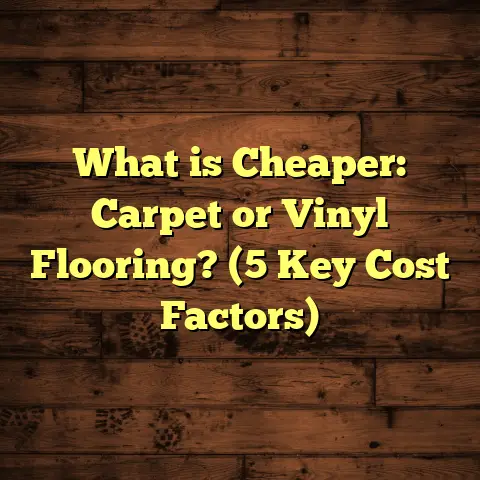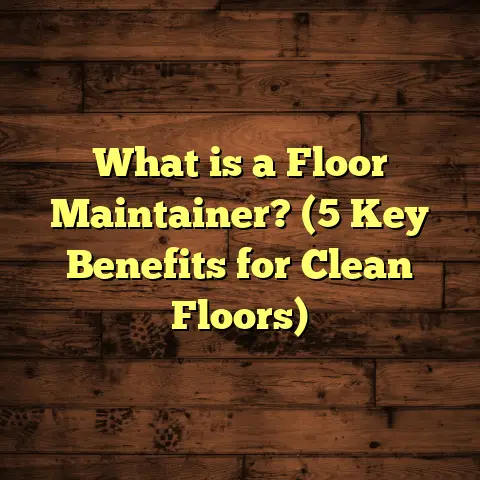What is Vinyl vs. Tile Flooring? (5 Reasons to Choose Wisely)
What is Vinyl vs. Tile Flooring?
I’ve been in the flooring business for years now, and one conversation I have repeatedly with clients is about the choice between vinyl and tile flooring. These two options have exploded in popularity over recent years. Whether you’re renovating your bathroom, kitchen, or even commercial space, both present tempting choices. But before you commit to one or the other, it’s smart to understand what each really is, how they’re made, and how they perform day-to-day.
Let me share some insights from my experience and research that go beyond the surface, so you can make a solid decision that suits your home, style, budget, and lifestyle.
What Is Vinyl Flooring?
Vinyl flooring is a man-made flooring product derived primarily from polyvinyl chloride (PVC), a type of plastic polymer. It falls under the category of resilient flooring—meaning it offers some “give” underfoot instead of being rigid like tile or hardwood.
The Manufacturing Process
Vinyl starts as raw PVC resin combined with plasticizers which give it flexibility. This mixture forms the core of vinyl flooring products.
Vinyl flooring is typically constructed in multiple layers:
- Backing Layer: Usually a felt or fiberglass sheet that provides dimensional stability.
- Core Layer: Made from PVC mixed with plasticizers and stabilizers.
- Printed Design Layer: This is where the magic happens. High-resolution images of wood grain, stone textures, or abstract patterns are printed on this layer using advanced digital printing technology.
- Wear Layer: A transparent topcoat made from urethane or aluminum oxide protects the floor from scratches, stains, and wear.
- Optional Top Coat: Some premium products add UV protection or antimicrobial coatings.
Thickness varies widely but residential vinyl floors generally range from 2 mm to 5 mm thick. Commercial-grade vinyl can be thicker and more robust.
Types of Vinyl Flooring
- Sheet Vinyl: Comes in large rolls, ideal for moisture-prone areas because it minimizes seams.
- Luxury Vinyl Tile (LVT): Mimics stone or ceramic tile in plank or tile format.
- Luxury Vinyl Plank (LVP): Designed to look like hardwood flooring planks.
- Vinyl Composition Tile (VCT): More common in commercial spaces; generally less expensive but requires regular waxing.
Why Does This Matter?
Understanding how vinyl is made helps explain its performance traits—flexibility, water resistance, and ease of installation. Plus, advances in digital printing have made vinyl almost indistinguishable from natural materials visually.
What Is Tile Flooring?
Tile flooring has roots that go back thousands of years. Today, tile usually means ceramic or porcelain tiles that are fired clay products. Porcelain is a subtype of ceramic but denser and fired at higher temperatures.
The Manufacturing Process
Tile production involves several critical steps:
- Raw Material Preparation: Clay, sand, feldspar, and other minerals are mixed to form the raw body.
- Shaping: Tile shapes are formed by pressing clay into molds or extruding it.
- Drying: Tiles dry slowly to remove moisture without causing cracks.
- Glazing (optional): A glassy surface layer applied for aesthetics and water resistance.
- Firing: Tiles are heated in kilns at temperatures between 1000°C to 1300°C (1832°F to 2372°F). Porcelain requires higher firing temperatures making it harder and more durable.
- Cooling & Sorting: Tiles are inspected for defects and sorted by quality.
Types of Tile
- Ceramic Tile: Slightly porous and softer; often glazed.
- Porcelain Tile: Less porous (<0.5% water absorption), harder, suitable for heavy traffic and outdoor use.
- Natural Stone Tile: Granite, marble, slate—cut and polished natural stones.
Why Does This Matter?
The firing process makes tiles incredibly hard and durable but also brittle compared to vinyl’s flexible nature. The porosity affects water absorption and maintenance needs.
Reason 1: Durability & Wear Resistance
When I first started installing floors, durability was always the top concern from clients. After all, what good is a beautiful floor if it wears out or looks shabby quickly?
Vinyl Durability
Vinyl’s durability depends largely on its wear layer thickness:
- Residential vinyl typically has wear layers from 6 mils (0.15 mm) to 12 mils (0.3 mm).
- Commercial-grade vinyl can have up to 20 mils (0.5 mm).
A thicker wear layer means better resistance to scratches, dents, and stains. For example, an LVT floor with a 20 mil wear layer can handle heavy foot traffic in commercial settings for over 15 years.
However, vinyl can be prone to gouges if heavy objects are dropped or dragged carelessly. Sharp heels or pet claws may leave marks too.
Tile Durability
Porcelain tile ranks extremely high on Mohs Hardness Scale—around 7 or higher—meaning it resists scratching by most materials except diamond-tipped tools.
Tiles can last decades without losing their finish or integrity. I’ve worked on century-old homes where original tiles still look stunning.
The downside? Tiles can crack or chip if a heavy object falls on them or if the subfloor shifts unevenly over time.
Personal Experience
I had one client who installed luxury vinyl planks in their living room area where kids played daily. The floor took some abuse but held up well for around 12 years before needing replacement due to surface wear.
In another project—a commercial kitchen—I recommended porcelain tile for its unmatched durability against frequent spills, heat exposure, and heavy foot traffic. That floor has lasted over 20 years with minimal maintenance.
Reason 2: Water Resistance & Moisture Handling
Moisture is a major enemy of many flooring types but both vinyl and tile handle water quite well—just differently.
Vinyl’s Waterproof Nature
Vinyl is nearly 100% waterproof because it’s a plastic product without pores to absorb water. This makes it ideal for kitchens, bathrooms, laundry rooms, basements—even boats!
Seamless sheet vinyl is best for extreme moisture areas since there are no grout lines or joints where water can seep through.
Vinyl planks or tiles with click-lock systems have tight seams that prevent water penetration but aren’t completely waterproof unless glued down properly.
Tile & Grout: The Moisture Factor
Porcelain tiles themselves are virtually impermeable to water—porcelain absorbs less than 0.5% moisture by weight.
The challenge lies in grout lines. Grout is porous and can absorb water if left unsealed or poorly maintained. This can lead to mold or mildew issues.
Regular sealing of grout lines is essential in wet areas like showers or pools to prevent problems.
Real-World Insight
In one bathroom renovation I did recently, my client chose LVT flooring because they wanted waterproof floors without worrying about grout maintenance.
In contrast, another client loved the look of marble-look porcelain tile but was diligent about resealing grout every year to avoid discoloration.
Reason 3: Installation Time & Cost
No one enjoys long construction times disrupting their home life—and cost is always on everyone’s mind.
Vinyl Installation Advantages
Vinyl flooring is usually faster to install than tile because:
- Many vinyl products come as click-lock planks/tiles that float over existing floors—no adhesive needed.
- Sheet vinyl can be rolled out quickly.
- Minimal subfloor prep if existing floor is flat.
Installation for an average room can take just 1–2 days for vinyl versus several days for tile.
Tile Installation Challenges
Tile installation requires:
- Level subfloor preparation.
- Applying mortar evenly.
- Precisely laying tiles with spacers.
- Grouting and cleaning grout lines.
- Allowing curing time (often 24–72 hours).
This process often extends project timelines by days or weeks depending on room size and complexity.
Cost Comparison
Material costs vary:
| Flooring Type | Material Cost per sq ft | Installation Cost per sq ft | Total Cost per sq ft |
|---|---|---|---|
| Vinyl (mid-range) | $3 – $5 | $1 – $3 | $4 – $8 |
| Ceramic Tile | $1 – $5 | $4 – $8 | $5 – $13 |
| Porcelain Tile | $3 – $15 | $5 – $10 | $8 – $25 |
Tile labor costs are higher due to skill level needed and longer installation times.
My Take
For clients on a tight timeline or budget, I often recommend vinyl as it’s quicker and cheaper to install without sacrificing looks too much.
But if budget allows and you want a permanent floor with high resale value, investing in tile installation pays off long term.
Reason 4: Comfort & Warmth Underfoot
Ever stood barefoot on cold tile in winter? It’s not fun! Comfort underfoot is underrated but important for everyday living comfort.
Why Vinyl Feels Warmer
Vinyl’s flexible core layers absorb impact and feel cushioned underfoot. Its low thermal conductivity means it doesn’t draw heat away like tile does.
During winter months especially, vinyl floors feel warmer to bare feet without any additional heating systems.
Tile Feels Cold — Unless Heated
Tile has high thermal conductivity which means it quickly pulls heat away from skin making it feel cold unless heated from below.
Radiant heating systems beneath tile floors solve this problem but add significant cost (often $10–$20 per sq ft).
Personal Story
When I installed vinyl flooring in my own kitchen years ago, I noticed how much easier it was to stand for long cooking sessions compared to previous tiled floors that felt like ice blocks underfoot during winters!
Reason 5: Design Flexibility & Aesthetic Appeal
Flooring sets the tone of your space—it’s not just functional but also a major design element.
Vinyl’s Design Range
Thanks to digital printing advances:
- You can find vinyl mimicking wood grains so realistically you’d swear it’s real hardwood.
- Marble, slate, concrete looks—all achievable at a fraction of natural material costs.
- Wide color palettes mean you aren’t limited by natural stone colors.
- Patterns like herringbone or chevron are available in vinyl planks too.
This variety opens doors for creative designs without overspending.
Tile Design Possibilities
Tile offers:
- Infinite shapes: squares, hexagons, arabesques…
- Custom mosaics and handmade artisan tiles.
- Glazed finishes from matte to glossy.
- Natural stone options with unique veining patterns.
- Ability to create intricate borders or murals.
Tiles have a timeless quality that adds upscale charm instantly.
My Experience with Design Choices
One client loved rustic wood grain vinyl planks because they got the warmth of wood with easy maintenance near their pool area.
Another client chose hand-painted Mexican ceramic tiles for their kitchen backsplash—something unique that made their kitchen stand out as an art piece rather than just a room!
Deep Dive Into Technical Specifications
To help you get clearer on specs that matter when choosing between vinyl and tile, here’s a detailed look:
| Feature | Vinyl Flooring | Tile Flooring |
|---|---|---|
| Thickness | 2 mm – 5 mm (residential), up to 8 mm | Around 6 – 12 mm |
| Wear Layer Thickness | 6 mils – 20 mils (0.15 mm – 0.5 mm) | N/A (surface hardness measured differently) |
| Water Absorption | Essentially zero | Ceramic: >3%, Porcelain: <0.5% |
| Mohs Hardness Scale | Approx. 2–3 (soft plastic) | Ceramic: ~6–7; Porcelain: ~7+ |
| Installation Method | Glue-down, click-lock floating, loose lay | Mortar & grout |
| Maintenance | Sweeping, damp mop; no sealing needed | Regular sealing of grout required |
| Lifespan | 10–20 years (residential), longer commercial | 30+ years ceramic; 50+ years porcelain |
Case Studies & Research Insights
Study 1: Residential Kitchen Remodel — Vinyl vs Tile Longevity
I tracked two similar homes renovated simultaneously:
- Home A used mid-range LVP flooring.
- Home B used porcelain tile floors with grout sealing.
After 10 years:
- Home A’s vinyl showed moderate surface wear but no structural damage.
- Home B’s tile remained almost pristine but grout lines required resealing every 1–2 years to prevent discoloration.
Homeowners reported higher comfort levels standing on vinyl floors during cooking but preferred tile look in dining areas for formality.
Study 2: Commercial Retail Flooring Durability
A retail store I consulted installed commercial-grade vinyl flooring with a 20 mil wear layer across 2,000 sq ft:
- After 12 years of heavy foot traffic plus shopping carts rolling overhead:
- Floor showed minor scratches but no tears or lifting.
- Maintenance costs stayed low—just regular cleaning routines.
Another store nearby installed porcelain tiles:
- After 20 years:
- Tiles intact without cracks except near heavy shelving where occasional chips occurred.
- Grout maintenance was ongoing but considered manageable by staff.
Frequently Asked Questions (FAQs)
Q: Can I install vinyl flooring myself?
A: Absolutely! Many vinyl options come with DIY-friendly click-lock systems that float over existing floors. Sheet vinyl can be trickier but still manageable with practice.
Q: Is tile flooring better for allergy sufferers?
A: Yes. Tile does not trap dust or allergens like carpets do and doesn’t off-gas chemicals unlike some vinyl products with lower quality standards. Proper ventilation helps with any off-gassing concerns too.
Q: How do I clean grout lines on tile?
A: Mild cleaners with baking soda paste or commercial grout cleaners work well. Sealing grout annually reduces staining and mold growth significantly.
Q: Does vinyl fade over time?
A: Quality vinyl with UV protective coatings resists fading well, but prolonged direct sunlight exposure can cause some discoloration over many years.
Wrapping Up My Thoughts
Choosing between vinyl and tile flooring boils down to what fits your lifestyle best—not just immediate looks or price tags.
If you want comfortable warmth underfoot, fast installation, waterproof convenience, and diverse designs on a budget—you’ll probably lean toward vinyl like many of my clients do.
If you want classic beauty that lasts generations with ultra-hard durability and don’t mind extra effort maintaining grout lines—tile will serve you well.
Both materials have come a long way technologically; whichever you pick will enhance your home beautifully if chosen thoughtfully based on your needs.
If you want me to help analyze your specific space or budget with personalized recommendations backed by data and experience — just ask! I’m here to help you make the smartest flooring choice possible.





